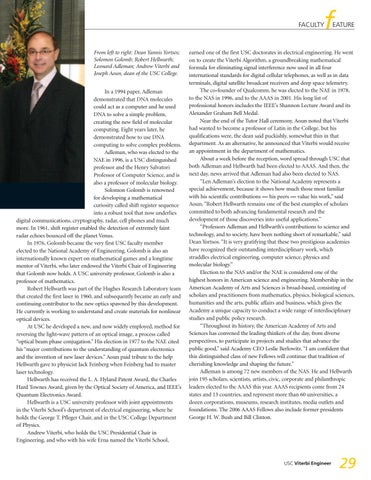f
FACULTY
From left to right: Dean Yannis Yortsos; Solomon Golomb; Robert Hellwarth; Leonard Adleman; Andrew Viterbi and Joseph Aoun, dean of the USC College. In a 1994 paper, Adleman demonstrated that DNA molecules could act as a computer and he used DNA to solve a simple problem, creating the new field of molecular computing. Eight years later, he demonstrated how to use DNA computing to solve complex problems. Adleman, who was elected to the NAE in 1996, is a USC distinguished professor and the Henry Salvatori Professor of Computer Science, and is also a professor of molecular biology. Solomon Golomb is renowned for developing a mathematical curiosity called shift register sequence into a robust tool that now underlies digital communications, cryptography, radar, cell phones and much more. In 1961, shift register enabled the detection of extremely faint radar echoes bounced off the planet Venus. In 1976, Golomb became the very first USC faculty member elected to the National Academy of Engineering. Golomb is also an internationally known expert on mathematical games and a longtime mentor of Viterbi, who later endowed the Viterbi Chair of Engineering that Golomb now holds. A USC university professor, Golomb is also a professor of mathematics. Robert Hellwarth was part of the Hughes Research Laboratory team that created the first laser in 1960, and subsequently became an early and continuing contributor to the new optics spawned by this development. He currently is working to understand and create materials for nonlinear optical devices. At USC he developed a new, and now widely employed, method for reversing the light-wave pattern of an optical image, a process called “optical beam phase conjugation.” His election in 1977 to the NAE cited his “major contributions to the understanding of quantum electronics and the invention of new laser devices.” Aoun paid tribute to the help Hellwarth gave to physicist Jack Feinberg when Feinberg had to master laser technology. Hellwarth has received the L. A. Hyland Patent Award, the Charles Hard Townes Award, given by the Optical Society of America, and IEEE’s Quantum Electronics Award. Hellwarth is a USC university professor with joint appointments in the Viterbi School’s department of electrical engineering, where he holds the George T. Pfleger Chair, and in the USC College Department of Physics. Andrew Viterbi, who holds the USC Presidential Chair in Engineering, and who with his wife Erna named the Viterbi School,
EATURE
earned one of the first USC doctorates in electrical engineering. He went on to create the Viterbi Algorithm, a groundbreaking mathematical formula for eliminating signal interference now used in all four international standards for digital cellular telephones, as well as in data terminals, digital satellite broadcast receivers and deep space telemetry. The co-founder of Qualcomm, he was elected to the NAE in 1978, to the NAS in 1996, and to the AAAS in 2001. His long list of professional honors includes the IEEE’s Shannon Lecture Award and its Alexander Graham Bell Medal. Near the end of the Tutor Hall ceremony, Aoun noted that Viterbi had wanted to become a professor of Latin in the College, but his qualifications were, the dean said puckishly, somewhat thin in that department. As an alternative, he announced that Viterbi would receive an appointment in the department of mathematics. About a week before the reception, word spread through USC that both Adleman and Hellwarth had been elected to AAAS. And then, the next day, news arrived that Adleman had also been elected to NAS. “Len Adleman’s election to the National Academy represents a special achievement, because it shows how much those most familiar with his scientific contributions — his peers — value his work,” said Aoun, “Robert Hellwarth remains one of the best examples of scholars committed to both advancing fundamental research and the development of those discoveries into useful applications.” “Professors Adleman and Hellwarth’s contributions to science and technology, and to society, have been nothing short of remarkable,” said Dean Yortsos. “It is very gratifying that these two prestigious academies have recognized their outstanding interdisciplinary work, which straddles electrical engineering, computer science, physics and molecular biology.” Election to the NAS and/or the NAE is considered one of the highest honors in American science and engineering. Membership in the American Academy of Arts and Sciences is broad-based, consisting of scholars and practitioners from mathematics, physics, biological sciences, humanities and the arts, public affairs and business, which gives the Academy a unique capacity to conduct a wide range of interdisciplinary studies and public policy research. “Throughout its history, the American Academy of Arts and Sciences has convened the leading thinkers of the day, from diverse perspectives, to participate in projects and studies that advance the public good,” said Academy CEO Leslie Berlowitz. “I am confident that this distinguished class of new Fellows will continue that tradition of cherishing knowledge and shaping the future.” Adleman is among 72 new members of the NAS. He and Hellwarth join 195 scholars, scientists, artists, civic, corporate and philanthropic leaders elected to the AAAS this year. AAAS recipients come from 24 states and 13 countries, and represent more than 60 universities, a dozen corporations, museums, research institutes, media outlets and foundations. The 2006 AAAS Fellows also include former presidents George H. W. Bush and Bill Clinton.
USC Viterbi Engineer
29
